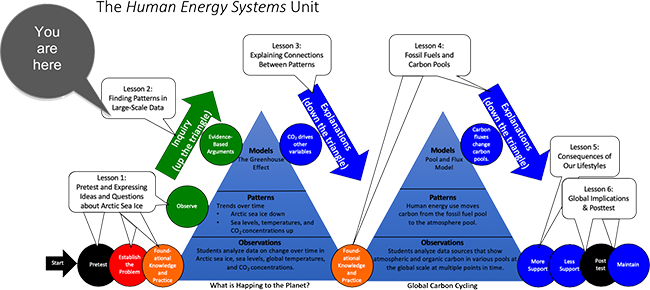Transformations in Matter and Energy Carbon TIME is an NSF-funded partnership led by Michigan State University
Human Energy Systems | Lesson 2 - Describing Patterns in Large-Scale Data
Overview
Using a jigsaw activity, students discuss generalizability, representation, and short-term variability using four different large-scale data sets related to climate change: global temperature, sea level rise, long-term atmospheric CO2 concentration, and short-term atmospheric CO2 annual cycle.
Guiding Question
What is happening to global temperature, atmospheric carbon dioxide, and sea level?
Activities in this Lesson
- Activity 2.1: Home Groups: Four Considerations for Large-Scale Data (45 min)
- Activity 2.2: Expert Groups: Analysis of Large-Scale Data (45 min)
- Activity 2.3: Home Groups: Share Expertise (60 minutes)
- Activity 2.4: Evidence-Based Arguments for Patterns in Earth Systems (30 min)
Unit Map

Target Student Performance
|
Activity |
Target Performance |
|
Lesson 2 – Finding Patterns in Large Scale Data (students as investigators) |
|
|---|---|
|
Activity 2.1: Home Groups: Four Considerations for Large Scale Data (45 min) |
Students in home groups express initial ideas about patterns and changes over time for four variables in Earth systems: global temperatures, global sea levels, Arctic sea ice, and atmospheric CO2 concentrations. |
|
Activity 2.2: Expert Groups: Analysis of Large-Scale Data (45 min) |
Students in expert groups investigate multiple representations of the four variables in and the Earth systems that they measure, generating explanations and questions. |
|
Activity 2.3: Home Groups: Share Expertise (60 min) |
Students return to home groups and share their expertise about patterns of change for four variables in Earth systems: global temperatures, global sea levels, Arctic sea ice, and atmospheric CO2 concentrations. |
|
Activity 2.4: Evidence-Based Argument for Earth Systems (30 min) |
Students compare patterns of change for the four Earth systems variables and record questions about what causes the patterns and how the patterns are related to one another. |
NGSS Performance Expectations
High School
- Earth’s Systems. HS-ESS2-2. Analyze geoscience data to make the claim that one change to Earth’s surface can create feedbacks that cause changes to other Earth systems.
- Earth’s Systems. HS-ESS2-2. Analyze geoscience data to make the claim that one change to Earth’s surface can create feedbacks that cause changes to other Earth systems.
- Weather and Climate. HS-ESS2-4. Use a model to describe how variations in the flow of energy into and out of Earth’s systems result in changes in climate.
- Earth’s Systems. HS-ESS2-6. Develop a quantitative model to describe the cycling of carbon among the hydrosphere, atmosphere, geosphere, and biosphere.
- Earth and Human Activity. HS-ESS3-5. Analyze geoscience data and the results from global climate models to make an evidence-based forecast of the current rate of global or regional climate change and associated future impacts to Earth systems.
- Earth and Human Activity. HS-ESS3-6. Use a computational representation to illustrate the relationships among Earth systems and how those relationships are being modified due to human activity.
Middle School
- Earth and Human Activity. MS-ESS3-5. Ask questions to clarify evidence of the factors that have caused the rise in global temperatures over the past century.

 Download PDF of Lesson 2 Teacher's Guide
Download PDF of Lesson 2 Teacher's Guide